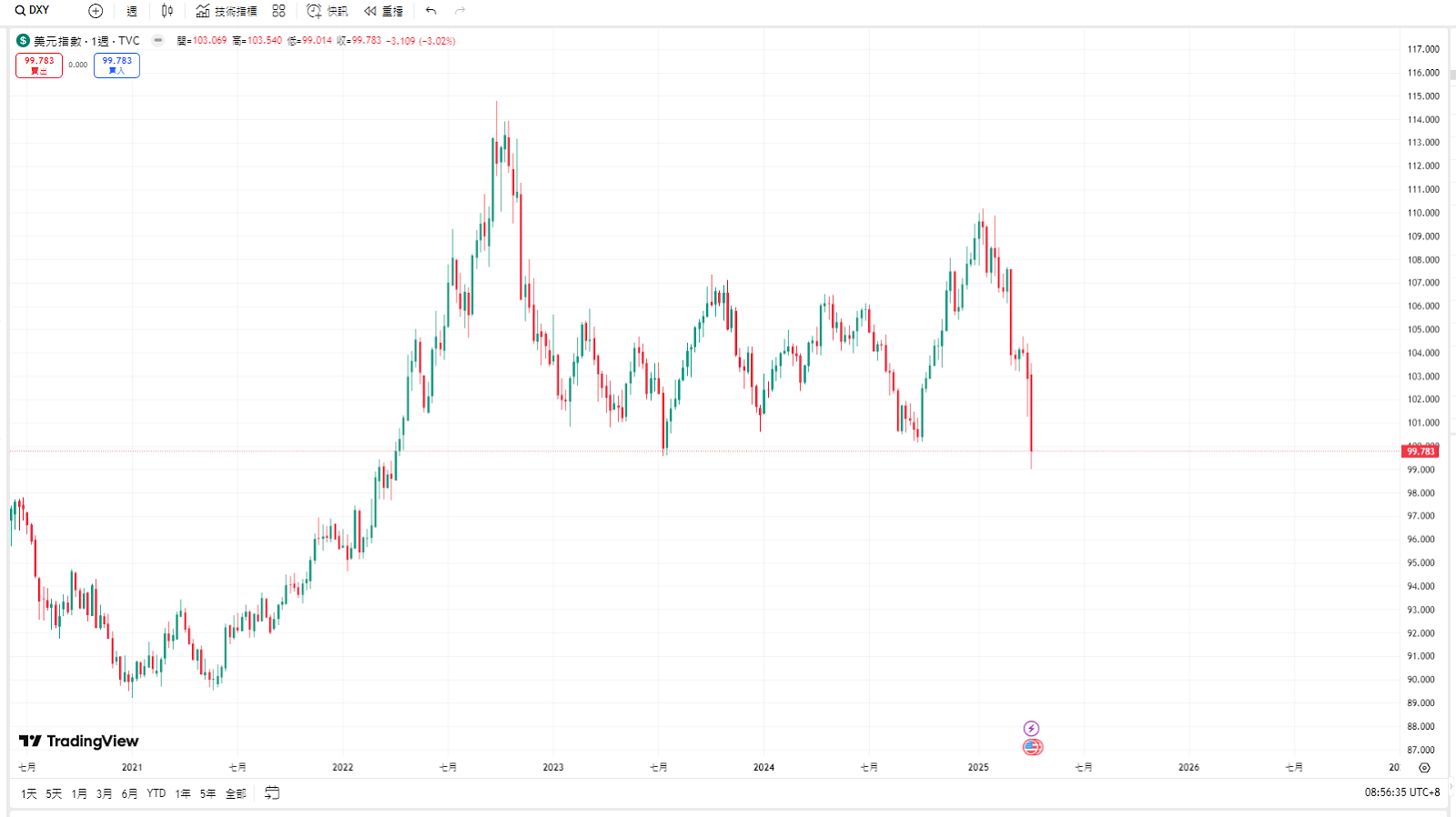I. Phenomenon-Level Reversal: Bitcoin Breaking $84,000 and the Dollar Index at a Three-Year Low
On April 12, 2025, the global financial market witnessed an epic divergence: Bitcoin surged 5.83% in a single day, breaking through the $84,000 mark.

Meanwhile, the Dollar Index (DXY) fell to 100.10, reaching its lowest point since 2022. Behind this seemingly contradictory asset performance lies a glimpse of the global economic landscape's fracture - the trust crisis of the traditional fiat currency system and the hedging narrative of crypto assets are reshaping capital flows.
Market data reveals deeper logic:
- Bitcoin's Resilience: Despite a nearly 1% decline during the week, Bitcoin completed a V-shaped reversal within 24 hours, with futures open interest surging 8.46% ($56.52 billion), and short liquidations reaching $13.47 million, indicating leveraged funds betting on a breakthrough.
- Dollar's Collapse: The Dollar Index fell below the 100 psychological level, with the Euro reaching a three-year high and the Swiss Franc hitting a decade-high, as capital accelerates its escape from the dollar system dominated by tariff policies.
- Market Consensus Split: Gold simultaneously rose to $3,227 per ounce, while Bitcoin's "digital gold" attribute first demonstrated its potential to rival traditional safe-haven assets during systemic risk.
II. The Deep Logic Behind the Dollar's Sharp Decline: Tariff Policies, Rate Cut Expectations, and Global De-Dollarization
1. The Backlash Effect of Trump's Tariff Policies
The Trump administration raised tariffs between the US and China from 84% to 125%, attempting to reshape the trade order but causing severe damage to the dollar's credibility. ING strategist Francesco Pesole noted: "The trade war raises US corporate costs, and market expectations of economic recession force the Fed to cut rates early, sharply reducing the dollar's attractiveness." Historical data shows that when the US weighted import tariff exceeds 25% (currently at 33%), the Dollar Index often enters a downward trajectory.
2. The Butterfly Effect of Fed Policy Shift
- Self-Fulfilling Rate Cut Expectations: US inflation's decline and inverted government bond yields (-0.45% spread between 10-year and 2-year) strengthen rate cut expectations, with markets betting on at least 3 rate cuts in 2025, stimulating risk assets with expectations of dollar liquidity easing.
- Quantitative Tightening (QT) Pause: The Fed pauses its balance sheet reduction plan, with TGA account funds continuing to be released until mid-April, injecting liquidity into the crypto market.
3. Accelerator of De-Dollarization
Emerging market central banks continue to increase gold holdings (15% annual increase), while retail investors turn to Bitcoin. The dollar's share in global foreign exchange reserves has dropped from 60% to 54%. Global Macro Investor points out: "Bitcoin's underlying censorship-resistant nature makes it a new type of hedging tool in geopolitical conflicts."
III. Three Major Engines Driving Bitcoin's Surge: Technology, Narrative, and Capital Migration
1. Technical "Triple Force" Breakthrough
Crypto analyst Jelle indicates that after breaking $91,200, Bitcoin will trigger the "Power of 3" technical model, targeting $140,000. The key support level ($83,000) and Mayer Multiple indicator (1.5 times 200-day moving average at $120,000) form a resonance, triggering technical buying.
2. Scarcity Narrative of Halving Cycle
After the 2024 halving, Bitcoin block rewards reduced to 3.125 coins, with new supply volume decreasing by 60% compared to 2020. VanEck research shows that prices often reach historical highs 12-18 months after halving, with the current cycle's peak potentially delayed until the second half of 2025.
3. Institutional Capital's Paradigm Shift
- ETF Suction Effect: Bitcoin ETF management scale breaks $80 billion, with an average daily net inflow of $230 million, and hedge funds deploying bullish option contracts.
- On-Chain Data Signals: At the $97,800 price point, there are 150,000 BTC "diamond hand" positions, and market panic selling failed to shake long-term holders' chips.
IV. Market Structure Transformation: From "Dollar Hegemony" to "Multi-Polar Monetary System"
1. Deepening Linkage Between Traditional Finance and Crypto Market
- Volatility Paradox: Bitcoin's 30-day volatility drops to its lowest since March (12.5%), while S&P 500 volatility (VIX) rises to 25, indicating improved crypto market maturity.
- Correlation Reversal: Bitcoin's 90-day correlation with the Nasdaq index drops from 0.7 to 0.3, breaking free from the risk asset label and showing an independent trend.
2. Global Capital Reconstruction Experiment
- Rise of Eastern Capital: Coinbase premium index narrows, with Asian trading session share rising to 58%, and Hong Kong crypto ETF's average daily trading volume breaking $500 million.
- Stablecoin's Bridge Role: USDT market cap breaks $180 billion, replacing dollar settlements in cross-border payments and weakening SWIFT system's influence.
V. Future Projection: The Ultimate Showdown of Bitcoin at $150,000 and Dollar Index at 90
1. Three Scenarios for Bitcoin
- Best Case (30% probability): DXY falls 3%, triggering a "1 standard deviation" effect, pushing Bitcoin to $143,000.
- Base Case (50% probability): Fed cuts rates 3 times, with Bitcoin's year-end target at $120,000-$125,000.
- Risk Scenario (20% probability): Escalating trade war triggers liquidity crisis, with Bitcoin retesting $73,000 support.
2. The Redemption and Decline of the Dollar System
- Short-Term Respite: If the US reaches a new agreement with trade partners (like USMCA 2.0), the Dollar Index may rebound to 103.
- Long-Term Trend: De-dollarization is irreversible, with Bitcoin potentially replacing 20% of gold reserves by 2030, becoming a central bank asset allocation option.
VI. Conclusion: At the Crossroads of a New Monetary War
As Bitcoin's market cap breaks $1.66 trillion (surpassing silver to become the world's third-largest asset), the century-old hegemony of the dollar is facing unprecedented challenges. The essence of this contest is the governance model between centralized fiat currency and decentralized protocols, and more fundamentally, a global capital repricing of "trust".
History doesn't simply repeat, but it rhymes. The memories of the 2019 trade war still linger, and the 2025 script has turned a new page - perhaps, as Real Vision analysts say: "Each collapse of the Dollar Index is crowning cryptocurrency's ascension."







